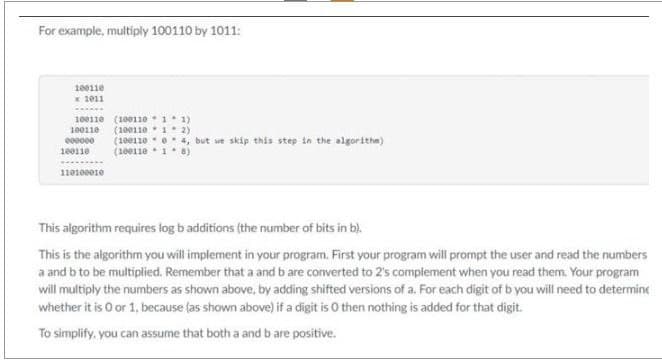For example, multiply 100110 by 1011: 100110 1011 100110 (10011011) 100110 (10011012) 000000 (10011004, but we skip this step in the algorithm) 100110 (10011018) 110100010 This algorithm requires log b additions (the number of bits in b). This is the algorithm you will implement in your program. First your program will prompt the user and read the numbers a and b to be multiplied. Remember that a and b are converted to 2's complement when you read them. Your program will multiply the numbers as shown above, by adding shifted versions of a. For each digit of b you will need to determine whether it is 0 or 1, because (as shown above) if a digit is O then nothing is added for that digit.
For example, multiply 100110 by 1011: 100110 1011 100110 (10011011) 100110 (10011012) 000000 (10011004, but we skip this step in the algorithm) 100110 (10011018) 110100010 This algorithm requires log b additions (the number of bits in b). This is the algorithm you will implement in your program. First your program will prompt the user and read the numbers a and b to be multiplied. Remember that a and b are converted to 2's complement when you read them. Your program will multiply the numbers as shown above, by adding shifted versions of a. For each digit of b you will need to determine whether it is 0 or 1, because (as shown above) if a digit is O then nothing is added for that digit.
Computer Networking: A Top-Down Approach (7th Edition)
7th Edition
ISBN:9780133594140
Author:James Kurose, Keith Ross
Publisher:James Kurose, Keith Ross
Chapter1: Computer Networks And The Internet
Section: Chapter Questions
Problem R1RQ: What is the difference between a host and an end system? List several different types of end...
Related questions
Question

Transcribed Image Text:For example, multiply 100110 by 1011:
100110
x 1011
100110 (10011011)
100110 (10011012)
000000 (10011004, but we skip this step in the algorithm)
(10011018)
100110
110100010
This algorithm requires log b additions (the number of bits in b).
This is the algorithm you will implement in your program. First your program will prompt the user and read the numbers
a and b to be multiplied. Remember that a and b are converted to 2's complement when you read them. Your program
will multiply the numbers as shown above, by adding shifted versions of a. For each digit of b you will need to determine
whether it is 0 or 1, because (as shown above) if a digit is O then nothing is added for that digit.
To simplify, you can assume that both a and b are positive.
Expert Solution
This question has been solved!
Explore an expertly crafted, step-by-step solution for a thorough understanding of key concepts.
This is a popular solution!
Trending now
This is a popular solution!
Step by step
Solved in 3 steps with 3 images

Recommended textbooks for you

Computer Networking: A Top-Down Approach (7th Edi…
Computer Engineering
ISBN:
9780133594140
Author:
James Kurose, Keith Ross
Publisher:
PEARSON

Computer Organization and Design MIPS Edition, Fi…
Computer Engineering
ISBN:
9780124077263
Author:
David A. Patterson, John L. Hennessy
Publisher:
Elsevier Science

Network+ Guide to Networks (MindTap Course List)
Computer Engineering
ISBN:
9781337569330
Author:
Jill West, Tamara Dean, Jean Andrews
Publisher:
Cengage Learning

Computer Networking: A Top-Down Approach (7th Edi…
Computer Engineering
ISBN:
9780133594140
Author:
James Kurose, Keith Ross
Publisher:
PEARSON

Computer Organization and Design MIPS Edition, Fi…
Computer Engineering
ISBN:
9780124077263
Author:
David A. Patterson, John L. Hennessy
Publisher:
Elsevier Science

Network+ Guide to Networks (MindTap Course List)
Computer Engineering
ISBN:
9781337569330
Author:
Jill West, Tamara Dean, Jean Andrews
Publisher:
Cengage Learning

Concepts of Database Management
Computer Engineering
ISBN:
9781337093422
Author:
Joy L. Starks, Philip J. Pratt, Mary Z. Last
Publisher:
Cengage Learning

Prelude to Programming
Computer Engineering
ISBN:
9780133750423
Author:
VENIT, Stewart
Publisher:
Pearson Education

Sc Business Data Communications and Networking, T…
Computer Engineering
ISBN:
9781119368830
Author:
FITZGERALD
Publisher:
WILEY